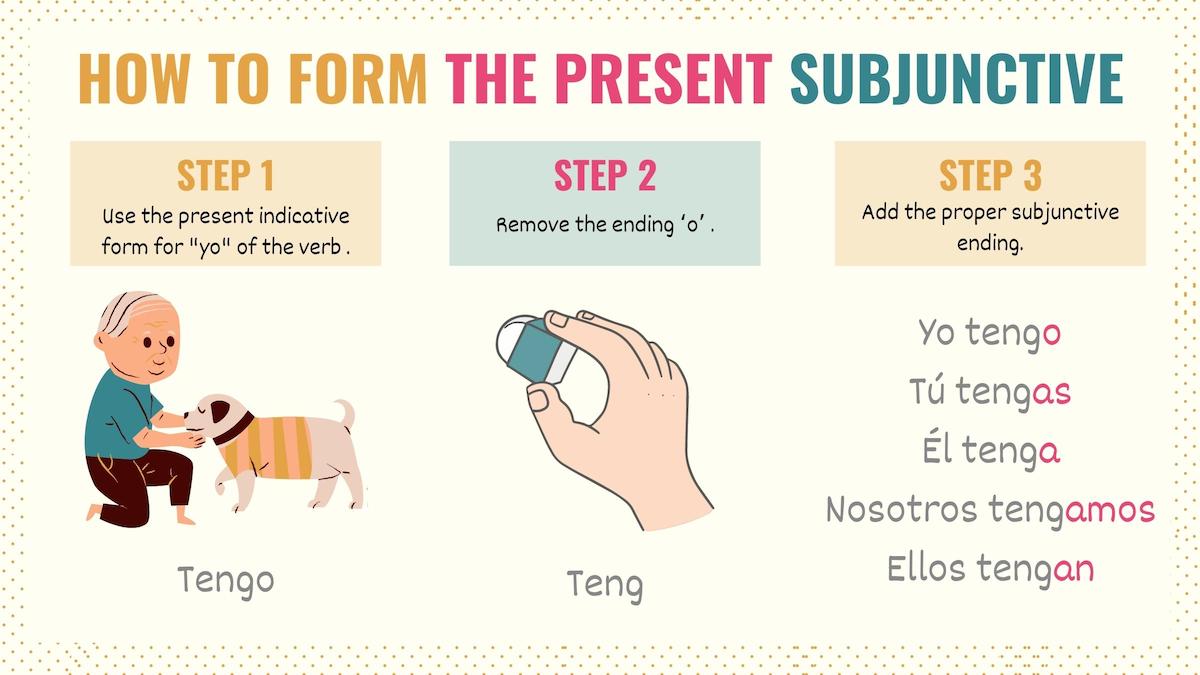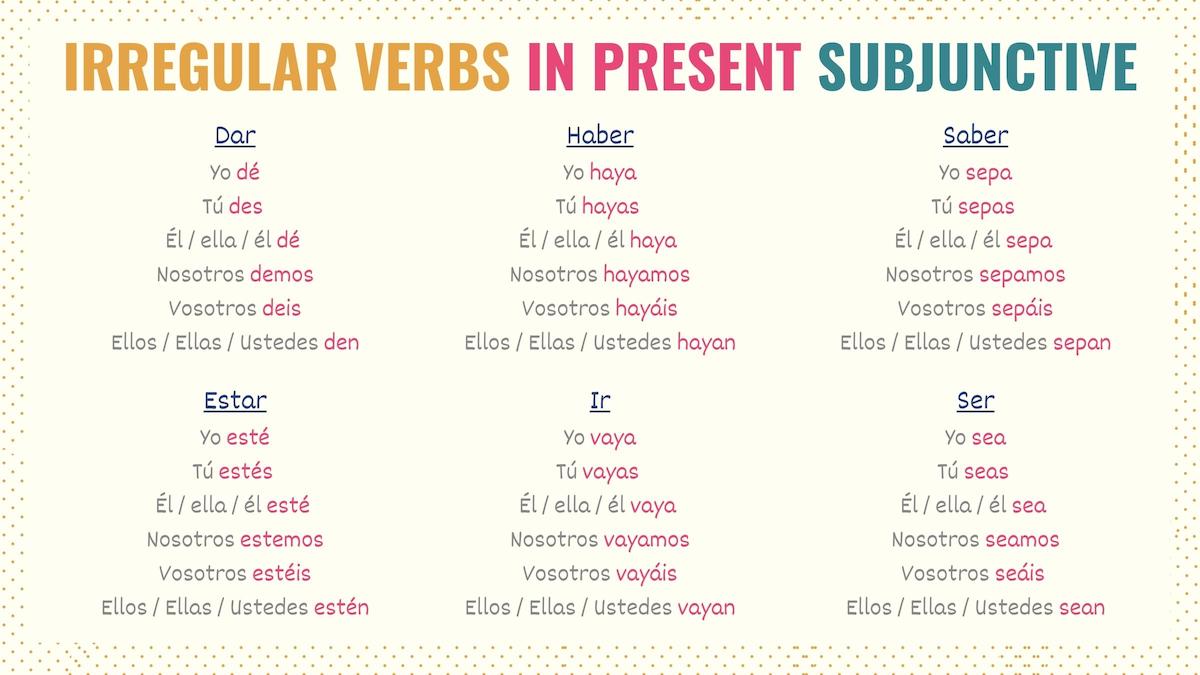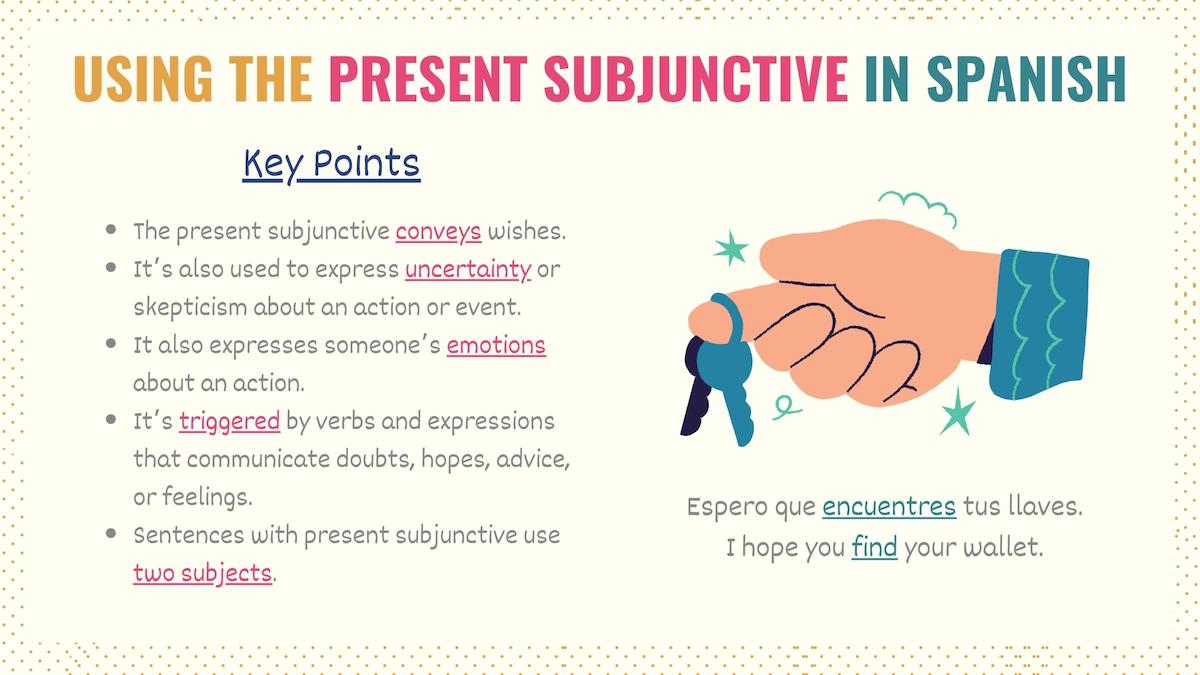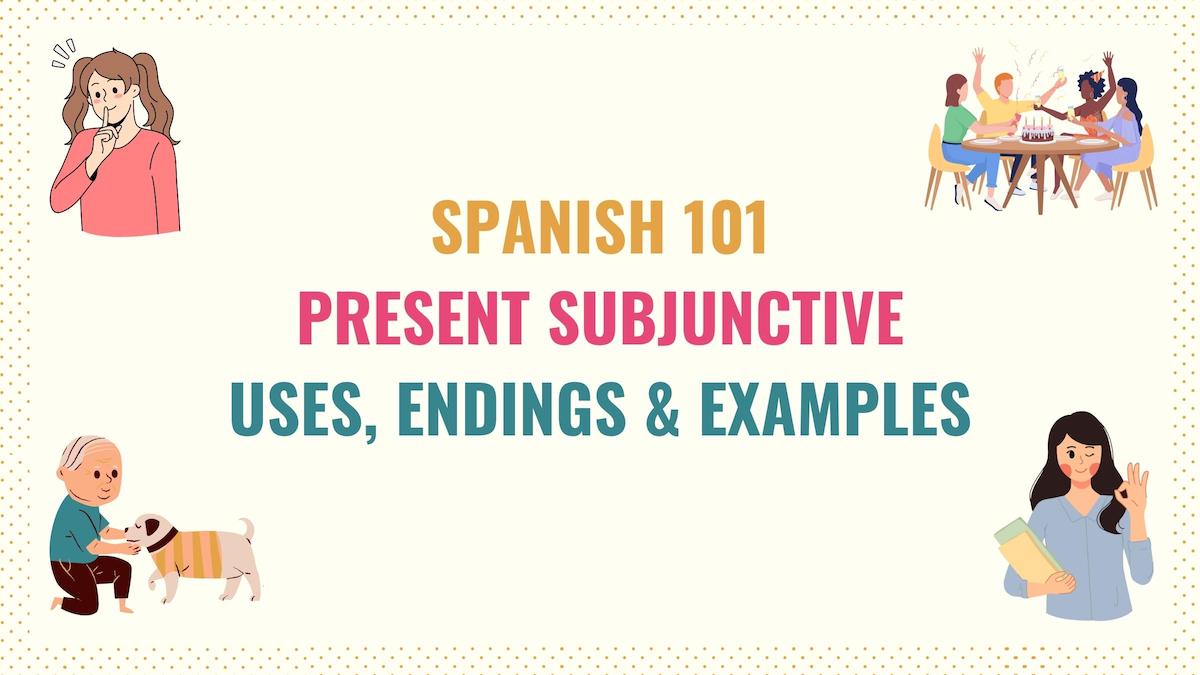The present subjunctive Spanish tense is used in ordinary life situations, such as wishing someone a good day or a happy birthday. Simply put, this subjunctive tense is indispensable for proper and effective communication. So, in this guide, we’ll cover the key information you need to master this tense.
Here is what you’ll find:
- Present Subjunctive Conjugations
- How & When to Use the Present Subjunctive
- Key Points
- Additional Resources for the Present Subjunctive
Spanish Present Subjunctive Conjugations
The present subjunctive conjugations are based on the present indicative forms of yo. In other words, the Spanish present subjunctive uses the regular, the most stem-changing, and the irregular verbs derived from the indicative form of ‘yo’.
Follow these steps to conjugate the present subjunctive in Spanish:
- Take the present indicative conjugations of ‘yo’.
- Drop the indicative ending ‘o’.
- Add the corresponding subjunctive endings.
Below is a conjugation chart with the Spanish present subjunctive endings bolded. Notice that –er and -ir verbs use the same subjunctive endings. This table uses escuchar, poner and construir as examples:
| Person | Escuchar | Poner | Construir |
|---|---|---|---|
| Yo | Escuche | Ponga | Construya |
| Tú | Escuches | Pongas | Construyas |
| Él / Ella Usted | Escuche | Ponga | Construya |
| Nosotros | Escuchemos | Pongamos | Construyamos |
| Vosotros | Escuchéis | Pongáis | Construyáis |
| Ellos / Ellas Ustedes | Escuchen | Pongan | Construyan |

Although many subjunctive conjugations are heavily based on the yo present indicative forms, the present subjunctive in Spanish has its own irregular forms and some stem-changing verbs that affect all subject pronouns. We’ll go deeper into these exceptions in the sections below.
Stem-changing verbs
In the indicative tenses, Spanish-stem changing verbs do not affect the pronouns ‘nosotros’ and ‘vosotros’. However, in the present subjunctive tense, -ir verbs with E to I and O to UE stem changes will affect all pronouns (including vosotros and nosotros).
Here is a list of the verbs and their stem changes:
E to I
-IR verbs with E to I spelling changes affect all subject pronouns:
Mi mamá quiere que nos vistamos bien.
My mom wants us to dress well.
Martín espera que repitáis la lección.
Martin hopes you guys repeat the lesson.
E to IE
- Convertir
- Divertir
- Mentir
- Preferir
In Spanish, -IR verbs with an E to IE change have this spelling change for all subject pronouns except nosotros and vosotros. However, with these verbs, ‘nosotros’ and ‘vosotros’ will have an E to I change for pronunciation purposes.
Check these examples:
Espero que te diviertas.
I hope you have fun.
Luis quiere que nos divirtamos.
Luis wants us to have fun.
O to UE
O to UE stem-changing verbs use this change for all pronouns except ‘nosotros’ and ‘vosotros’. These pronouns will have an O tu U stem change for these verbs.
- Dormir
- Morir
Here are some examples:
Te sugiero que te duermas temprano.
I suggest you sleep early.
El doctor nos sugiere que nos durmamos temprano.
The doctor suggests we sleep early.
On top of these vocalic changes, verbs ending in -car, -gar, and –zar (such as buscar, pagar, and almorzar) have consonant changes in the present subjunctive. These changes are based on the spelling modifications in the ‘yo’ form of the preterite tense.
Take pagar as an example. In the preterite form, the conjugation for yo is ‘pagué’. Once we remove the preterite termination, the present subjunctive forms of pagar are:
| Person | Pagar |
|---|---|
| Yo | Pague |
| Tú | Pagues |
| Él / Ella Usted | Pague |
| Nosotros | Paguemos |
| Vosotros | Paguéis |
| Ellos / Ellas Ustedes | Paguen |
Irregular verbs in the present subjunctive
The Spanish present subjunctive has six irregular verbs:
- Yo dé
- Tú des
- Él / ella / él dé
- Nosotros demos
- Vosotros deis
- Ellos / Ellas / Ustedes den
- Yo esté
- Tú estés
- Él / ella / él esté
- Nosotros estemos
- Vosotros estéis
- Ellos / Ellas / Ustedes estén
- Yo haya
- Tú hayas
- Él / ella / él haya
- Nosotros hayamos
- Vosotros hayáis
- Ellos / Ellas / Ustedes hayan
- Yo vaya
- Tú vayas
- Él / ella / él vaya
- Nosotros vayamos
- Vosotros vayáis
- Ellos / Ellas / Ustedes vayan
- Yo sepa
- Tú sepas
- Él / ella / él sepa
- Nosotros sepamos
- Vosotros sepáis
- Ellos / Ellas / Ustedes sepan
- Yo sea
- Tú seas
- Él / ella / él sea
- Nosotros seamos
- Vosotros seáis
- Ellos / Ellas / Ustedes sean
Notice that endings for irregular verbs are very similar to the regular present subjunctive endings, with the difference that some irregular verbs use accent marks.

Now that you know the conjugation rules for this tense, let’s check how and when to use it.
When to Use the Present Subjunctive in Spanish?
In Spanish, the present subjunctive is used to:
- Request, advise, or suggest something to someone.
- Express doubt or skepticism regarding the reality or result of an action.
- Convey emotions about an action.
- Communicate wishes and hopes.
Based on these uses, the present subjunctive in Spanish is triggered by verbs and phrases that express hopes, feelings, and uncertainty. For instance:
- Aconsejar que: To advise
- Alegrar que: To be glad
- Creer que: To believe
- Cuando: When
- Desear que: To wish
- Dudar que: To doubt
- Es necesario que: It’s necessary that
- Es posible que: It’s possible that
- Es probable que: It’s probable that / It’s likely
- Esperar que: To hope
- Exigir que: To demand
- Gustar que: To like
- Molestar que: To bother
- Necesitar que: To need
- No creer que: Don’t believe
- No estar seguro de que: Don’t be sure
- Ojalá: Hopefully / I wish
- Pedir que: To ask
- Preferir que: To prefer
- Probablemente: Probably
- Querer que: To want
- Quizás: Maybe
- Recomendar que: To recommend
- Sugerir que: To suggest
- Tal vez: Maybe
Examples of the present subjunctive
Here are some sentences using the present subjunctive:
Advices, requests, and suggestions:
Les sugiero que hablen con el gerente.
I suggest you guys talk to the manager.
La maestra nos pide que guardemos silencio.
The teacher asks us to be quiet.
Doubts and uncertainty:
Es muy probable que hoy haga calor.
It will likely be hot today.
¿No crees que pueda cargar la caja?
Don’t you think that I can move the box?
Convey emotions:
Nos alegra que estés bien.
We’re glad that you are okay.
Me molesta que no escuches lo que digo.
It bothers me that you don’t listen to what I say.
Express wishes and hopes:
Esperamos que pases un feliz cumpleaños.
We hope you have a happy birthday.
Cuando vayan a la tienda, traigan más leche.
When you go to the store, bring more milk.
Unlike the present indicative, notice that none of these examples refer to factual information. The present subjunctive (as shown in the example above) relates to imaginary events.
Let’s check these sentences together:
Ojalá llueva hoy.
Hopefully, it will rain today.
Espero que tengas un buen día.
I hope you have a good day.
Although the way I feel is real (underlined), the actual actions (bolded) are imaginary and hypothetical. At the moment of my wish, we don’t know if you’re going to have a good day or if it’s going to rain. Whatever my wishes are, they’re not factual because they haven’t happened.
This is what the present subjunctive in Spanish allows you to do.
Take Note: Sentences with the subjunctive mood often involve two subjects. The first is the person expressing feelings, doubts, or wishes (main clause). And the second is the person or thing to whom these emotions are directed (dependent clause).

Key Points
The present subjunctive Spanish tense is crucial for communicating your thoughts more precisely. Here are some key points you should keep in mind:
- The present indicative forms of yo heavily influence the conjugation of the Spanish present subjunctive.
- IR verbs with stem changes affect all subject pronouns. Be aware that nosotros and vosotros may follow different spelling changes than the rest of the subject pronouns.
- The Spanish present subjunctive has six irregular verbs:
- ir, ser, estar, dar, haber, and saber.
- The present subjunctive in Spanish expresses doubts and emotions about what a person does.
- It also conveys wishes and suggestions we have for someone.
- Some real-life scenarios where you can apply this tense are:
- Wish someone a good day or happy birthday.
- Wish for better weather.
- Advise people to do something.
- Tell someone what we hope or want them to do.
Spanish Present Subjunctive Quiz
The present subjunctive can be challenging to understand. However, it’s necessary if you want to improve your Spanish. So, you should start practicing and incorporating this tense as soon as possible. If you’re ready to test your knowledge, you can take this Spanish present subjunctive quiz.
Present Subjunctive Spanish Additional Resources
The present subjunctive is heavily influenced by the conjugations of the present indicative tense. In addition to helping you with your conjugations, having a good understanding of the indicative mood can be a great asset to grasping the present subjunctive.
To practice different subjunctive conjugations, you should check our verb conjugation center. This resource not only contains the most common verbs in Spanish, but you’ll also find conjugation quizzes.
The present form is one of the four subjunctive tenses. As your command of the language progresses, you should aim to understand all the subjunctive mood tenses in Spanish.
Download the Present Subjunctive Spanish PDF
The present subjunctive tense is the most common of the subjunctive tenses used in Spanish. It’s also one of the more advanced tenses for learners and takes time to master. Feel free to download a PDF copy for this guide with all the graphics and key points so you can revisit this topic when needed.



